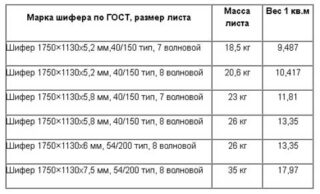Facing roofing and wall materials are called slate, more often they mean the asbestos-cement or slate variety. Flat slate is a durable and reliable coating that serves without loss of quality for about two to three decades. During transportation and installation, take into account that the panels are afraid of point impacts, from which the material can burst.
- Composition and properties of different types of slate
- Natural sheet slate
- Asbestos cement slate
- Chrysotile cement material
- Fiber cement
- Material production
- Characteristics of flat slate
- Comparison of flat slate and cement particle board
- Useful area of sheets taken into account in the calculation
- Indicators of other types of material
- Applications
- Arrangement of beds in the yard
- As formwork
- Interior decoration
- Fence device
- Facade decoration
- Floor covering installation
Composition and properties of different types of slate
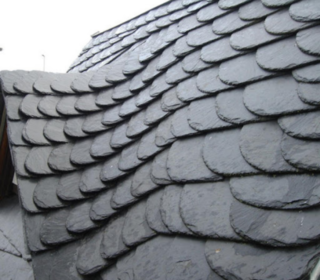
Usually the material includes shale, feldspar, brown iron ore, coal are added to the composition as impurities for a variety of properties. Slate has long been used for roofs as a wear-resistant coating. Gradually, this type gave way to asbestos cement sheets, which subsequently took a strong position in the building materials market.
Natural sheet slate
Slate is split off from solid rock; such plates are rarely used in modern construction. These are panels with a thickness of 5 mm, measuring from 20 x 15 to 30 x 60 cm. There are dark shades of red, green, but more often dark gray.
Slate tiles properties:
- environmentally friendly, durable material lasts up to 100 years;
- density - 2.7 - 2.9 g / cm³;
- porosity - within 0.35 - 3.0%;
- compressive strength —55 - 245 MPa.
Tiles of different sizes and shapes look beautiful, do not change their characteristics when exposed to the sun.
Asbestos cement slate
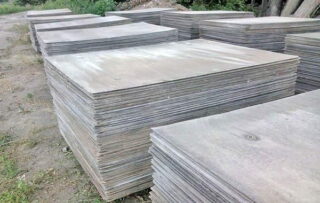
In construction, they are used in the form of wave sheets and flat slate for bricks, tiles, slate. The material is used not only as a roof covering, but also as a facade finish and other structural elements in buildings.
ACL properties:
- strength, long service life (more than 30 years);
- affordable cost;
- low heat conductivity;
- in terms of flammability, they are classified as NG (non-combustible);
- muffles sounds, acts as an insulator from electricity;
- high moisture resistance, inability to absorb and retain water.
Asbestos-cement flat sheet has a disadvantage in the form of amphibole asbestos fibers, which are recognized as harmful to health. Now they use chrysolite asbestos, which is less dangerous.
Chrysotile cement material
Chrysolite asbestos fibers are considered not as carcinogenic as asbestos, therefore in Russia it is allowed to produce 3 thousand varieties of products using such raw materials.
Building material characteristics:
- the sheet is thinner than asbestos-cement, therefore its weight is reduced by 6.1 kg, which has a positive effect on the installation conditions;
- the fibers are more durable, therefore the strength index increases.
For a good perception in the design ensemble of the exterior, chrysotile cement slate is painted in different colors.
Fiber cement
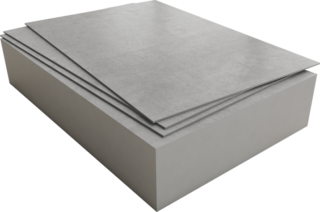
The composition of the material includes cement, mineral additives and reinforcing cellulose fibers. It has no restrictions, since it refers to environmentally friendly materials.
Fiber cement slate qualities:
- does not rot, does not collapse under the action of atmospheric chemistry;
- withstands prolonged exposure to ultraviolet radiation;
- has low thermal conductivity, protects against noise.
Smooth slate with fiberglass is inexpensive, it is of good quality due to verified technology and control at all stages of production.
Material production
In the process, pressed and unpressed material is obtained. First, a solution is formed with the inclusion of the necessary components, then it is kept until the required humidity is reached.
There are 2 methods:
- the mass in the forms receives properties in natural conditions of humidity for curing;
- the sheets begin to be pressed for compaction, then they are kept in a standard microclimate.
Plates obtained by the second method are more durable, withstand loads, including shock loads. The density is increased, the resistance to frost is increased. The cost of pressed panels is higher.
Characteristics of flat slate

The weight of the slate and its dimensions are the main parameters that are taken into account in the process of drawing up a project. In the construction of the roof, more massive rafters and lathing are needed, and the facade finish will require a reinforced foundation.
Dimensions and weight of unpressed types of flat sheet slate:
- 3.0 x 1.5, thickness 12 mm - 14.4 kg;
- 3.0 x 1.5 x 10 - 8.7 kg;
- 3.0 x 1.5 x 8 - 7.0 kg;
- 2.0 x 1.5 x 10 - 5.8 kg;
- 2.0 x 1.5 x 8 - 4.67 kg;
- 1.5 x 1.0 x 10 - 2.9 kg.
Physicochemical properties of flat slate slabs:
- unpressed ones withstand torsion and bending loads up to 18 MPa, pressed ones do not collapse at values up to 23 MPa;
- the density is low in two varieties, LDL has an indicator of 1600 kg / m³, LPP - 1800 kg / cm³;
- impact strength of sheets (the ability to withstand point loads) for non-pressed 2.5 kJ / m², non-pressed - 2.0 kJ / m².
Frost resistance of LPL - 25 cycles, LPL - 50. Slate plate with asbestos-cement fibers has a thermal conductivity of 0.35 W / m * K.
The slate is non-flammable, since there are no components in it that could support combustion. In critical fire conditions, sheets do not burst at temperatures up to + 600 ° C. After heating to such values, the slate fibers are irretrievably deformed, the material cracks. In the event of a fire, the slate does not heat up, so firefighters can move along the roof for ease of extinguishing.
Comparison of flat slate and cement particle board
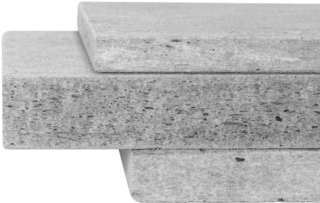
The similarity of the materials is that cement acts as a binder, plasticizers, modifiers are included, the bulk consists of a filler. The difference is that wood chips are used in DSP, and straight slate is made from various fibers (fiber, asbestos, chrysolite).
Both materials can be attached to the roof and façade, but CBPB weighs more and is thicker. The difference is due to the size of the fibers that are used.
The useful area of the sheets taken into account in the calculation
For flat sheets of slate, the full and useful area coincide, since there are no undulating protrusions on the surface, therefore, it is easier to calculate the material for the roof, wall, facade.
For counting, measurements will be required:
- the length of the front of the building, add the length of the pediment overhang;
- the length of the slope from the top of the wall to the ridge, add the size of the eaves overhang of the roof.
The measurements obtained are used to calculate the number of flat slabs in a horizontal row and the number of elements in a vertical layout. Horizontally, the overlap of smooth slate is taken at the level of 16 - 20 cm, and vertically - 18 - 21 cm. The difference depends on the slope of the roof. The greater the slope, the less overlap.
Indicators of other types of material
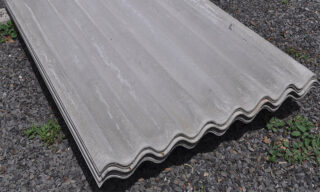
Wave unified slate differs in dimensions that exceed the usual types, but smaller than that of the reinforced type. Unified profiles are produced with a thickness of 5.2 or 5.8 mm.
Indicators of panel mass, depending on the size and thickness;
- sheet size 1.75 x 0.98, thickness 5.2 mm, wave type 40/150 weighs 18 kg;
- 1.75 x 0.98 x 5.8 mm, wave 40/150 - 21.8 kg;
- 1.75 x 1.13 x 5.2 mm, wave 40/150 - 18.7 kg;
- 1.75 x 1.13 x 5.8 mm, wave 40/150 - 23.2 kg.
They produce unified panels with a length of 1.75 m, a width of 0.98 or 1.13 m, and a useful area of 0.94 or 1.25 m. The useful squareness of the sheet depends on the height and width of the wave.
An ordinary variety is produced to cover houses, small buildings. For a roof of a small square, there are fewer cuts and a choice of the location of the sheets due to their small dimensions. Special additional elements are placed on skates and valleys. Sizes of sheets in length are standard 1.75 m, width also does not differ - 1.13 m, thickness depends on the type of waves, and is: 5.2; 5.8; 6.0; 7.5 mm.
Weight of standard sheets of common type:
- sheet size 1.75 x 1.13, thickness 5.2 mm, wave type 40/150 weighs 20.6 kg;
- 1.75 x 1.13 x 5.8 mm, wave 40/150 - 26.1 kg;
- 1.75 x 1.13 x 6.0 mm, wave 54/200 - 28 kg;
- 1.75 x 1.13 x 7.5 mm, wave 54/200 - 35 kg.
The reinforced look is produced with a wavy profile with a reinforced profile. The dimensions of the sheets are superior to other types: length - up to 2.8 m, width - 1.0 m, thickness of the profile panel 0.8 cm.This type is used to cover the roof of production workshops, warehouses of large quadrature. In the construction of private buildings, housing, it is rarely used, since the sheets differ in increased weight (more than 35 kg).
When using reinforced sheets, a massive recessed foundation is required, because overall loads increase.
Applications
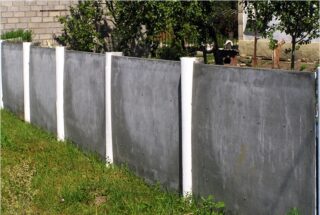
The material is tough and durable, flat sheets have a wider scope of use than corrugated ones. After fastening in the installation position, they do not change their horizontal dimensions, do not bend. The models of application are varied, since the mechanical and chemical properties are suitable for different types of enclosing structures and coatings.
Smooth slate is used as a final finish or is installed as an auxiliary option when pouring concrete, installing monolithic reinforced concrete floors in buildings. The material is mounted in combination with insulation, waterproofing, if required by the operating conditions. Sometimes the sheets are attached to the supports without additional "pie".
Arrangement of beds in the yard
The material is used by landscape designers to decorate front gardens on the site, flower beds in the garden or beds in the garden. In this case, the property of the material does not allow moisture to pass through, which prevents the erosion of the filled soil of the flower garden.
Operating procedure:
- sheets are cut to size using a grinder or jigsaw, fastened to posts made of metal corners, professional pipes to self-tapping screws with rubber gaskets;
- after installation, they are painted in different colors.
Round fences cannot be made; if a turn is needed, they perform a segment line from separate straight segments. The height can be different, depending on the design development.
As formwork
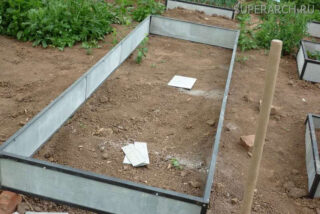
Formwork for the foundation using sheets of smooth slate is a common phenomenon. Slate does not absorb moisture, so concrete hardens under normal humidity conditions. Durable panels do not crack when loaded with a heavy mass of mortar.
The sheets are removed after the concrete has hardened, sometimes they are left as part of the foundation structure (permanent formwork).
Interior decoration
A smooth surface is given to the walls by attaching slate plates to the walls. Such finishing inside is done in industrial premises of warehouses, workshops. To install the sheets, a frame is constructed from a steel profile or a wooden slat.
The panels are fixed with self-tapping screws for metal or wood. After installation, the surface is painted with oil, pentaphthalic compounds.
Fence device
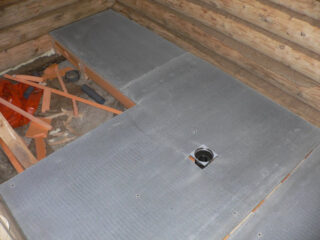
Straight panels are used as filling when arranging a fence. A height of 1.13 m is obtained if the panels are mounted directly from the ground. They make a base of masonry or concrete to make a higher fence, or put slate at 1.5 - 2 heights.
The material of the pillars is red and white bricks, metal, the supports are made of wood, prefabricated reinforced concrete pillars. For fixation, hardware with a galvanized layer is used.
Facade decoration
The outer walls are trimmed with sheets of even slate along with other finishing materials. The panels are fastened according to the type of a hinged facade, at the same time a layer of insulation, waterproofing, and a windproof membrane is installed.
A smooth surface can be painted; for this, acrylic and latex compounds for outdoor use are used. The seams between the sheets are sealed with putty on the grid.
Floor covering installation
In living quarters, such floors are not suitable, but in the garage, workshop, shed, you can see slabs of flat slate on the floor. The material does not conduct current, therefore it serves as a dielectric when working with electricity.
The panels are placed on a bed of gravel, expanded clay. In two layers with alternating seams, the sheets are mounted if they arrange beams and logs as the base.

